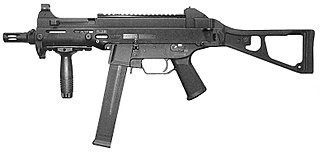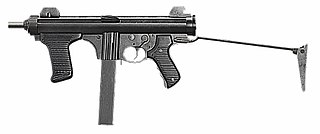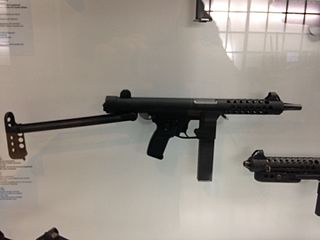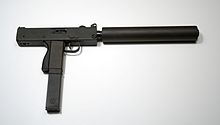
The Thompson submachine gun is a blowback-operated, selective-fire submachine gun, invented and developed by United States Army Brigadier General John T. Thompson in 1918. It was designed to break the stalemate of trench warfare of World War I, although early models did not arrive in time for actual combat.

The .45 Reising submachine gun was manufactured by Harrington & Richardson (H&R) Arms Company in Worcester, Massachusetts, USA, and was designed and patented by Eugene Reising in 1940. The three versions of the weapon were the Model 50, the folding stock Model 55, and the semiautomatic Model 60 rifle. Over 100,000 Reisings were ordered during World War II, and were initially used by the United States Navy, Marine Corps, and the United States Coast Guard, though some were shipped to Canadian, Soviet, and other allied forces to fight the Axis powers.

The Military Armament Corporation Model 10, officially abbreviated as "M10" or "M-10", and more commonly known as the MAC-10, is a compact, blowback operated machine pistol/submachine gun that was developed by Gordon Ingram in 1964. It is chambered in either .45 ACP or 9mm. A two-stage suppressor by Sionics was designed for the MAC-10, which not only abates the noise created but makes it easier to control on full automatic.

The .380 ACP, is a rimless, straight-walled pistol cartridge developed by firearms designer John Moses Browning. The cartridge headspaces on the mouth of the case. It was introduced in 1908 by Colt, for use in its new Colt Model 1908 pocket hammerless semi-automatic, and has been a popular self-defense cartridge ever since, seeing wide use in numerous handguns. Other names for .380 ACP include .380 Auto, 9×17mm, 9mm Browning, 9mm Corto, 9mm Kurz, 9mm Short, and 9mm Browning Court. It should not be confused with .38 ACP. The .380 ACP does not strictly conform to cartridge naming conventions, named after the diameter of the bullet, as the actual bullet diameter of the .380 ACP is .355 inches.

The Heckler & Koch UMP is a submachine gun developed and manufactured by Heckler & Koch. Heckler & Koch developed the UMP as a lighter and cheaper successor to the MP5, though both remain in production. The UMP has been adopted for use by various countries including Brazil, Canada, and the United States. A small number of UMPs chambered in .45 ACP were officially purchased by the 5th Special Forces Group of the United States Army Special Forces, with some of the weapons seeing limited service in the early years of the Iraqi insurgency, making them one of the more popular submachine guns being deployed by the U.S. military personnel in recent conflicts around the world.
The Remington Model 870 is a pump-action shotgun manufactured by Remington Arms Company, LLC. It is widely used by the public for shooting sports, hunting and self-defense, as well as by law enforcement and military organizations worldwide.

A firearm is said to fire from an open bolt or open breech if, when ready to fire, the bolt and working parts are held to the rear of the receiver, with no round in the chamber. When the trigger is actuated, the bolt travels forward, feeds a cartridge from the magazine or belt into the chamber, and fires that cartridge in the same movement. Like any other self-loading design, the action is cycled by the energy released from the propellant, which sends the bolt back to the rear, compressing the mainspring in readiness for firing the next round. In an open-bolt gun firing semi-automatically, the bolt is caught and held at this point by the sear after each shot; and in automatic open-bolt fire, it's caught and held in this manner whenever the trigger is released. In contrast to this, in closed-bolt guns, the trigger and sear do not affect the movement of the bolt directly.
The Franchi SPAS-15 is a dual-mode 12 gauge combat shotgun manufactured by the Italian company Luigi Franchi S.P.A.

The Cobray Company was an American developer and manufacturer of submachine guns, automatic carbines, handguns, shotguns, and non-lethal 37 mm launchers. These were manufactured by SWD. In the 1970s and 1980s, Cobray was a counter terrorist training center in addition to being an arms maker under the leadership of Mitch WerBell.
The Heckler & Koch MG4 is a belt-fed 5.56 mm light machine gun designed and developed by German firearm manufacturer Heckler & Koch. It was developed in the late 1990s and first seen publicly in September 2001. It has been selected to replace the 7.62 mm MG3 general-purpose machine gun in the Bundeswehr at the squad support level; it will complement the MG3 in other roles. It will also be the secondary armament of the new Puma infantry fighting vehicle. Overall, it is designed to be light, provide maximum safety to the user and function reliably under adverse conditions using a wide range of ammunition from different manufacturers, without the need to adjust the gas system. It was known as the MG43 prior to its adoption by the Bundeswehr.

The Beretta M12 is a 9×19mm Parabellum caliber submachine gun designed by Beretta. Production started in 1959, the first users were the Italian Carabinieri, Italian State Police and the Guardia di Finanza, though in limited numbers; it was only widely issued beginning in 1978, replacing the old Beretta MAB. In 1962 the Italian Army bought a limited number of Franchi LF-57 submachine guns, judged better than the M12 but never issued to the troops, and only in 1992 the M12S2 variant was introduced, in very limited numbers. The Italian Air Force bought instead many M12S and M12S2 for the airport security units. However, the weapon had a higher initial success in the Arab countries and South America.

The FAMAE SAF is a submachine gun produced and manufactured by FAMAE since 1993.
The SG 540 is a 5.56×45mm NATO assault rifle developed in the early 1970s by Schweizerische Industrie Gesellschaft of Neuhausen, Switzerland as a private venture primarily destined for export markets and as a potential replacement for the 7.5×55mm Swiss SG 510 automatic rifle known as the Stgw 57 in Swiss service.

The Madsen M-50 or M/50 is a submachine gun introduced in 1950. It was produced by the Danish company Dansk Industri Syndikat of Copenhagen, Denmark.

The M3 is an American .45-caliber submachine gun adopted by the U.S. Army on 12 December 1942, as the United States Submachine Gun, Cal. .45, M3. The M3 was chambered for the same .45 ACP round fired by the Thompson submachine gun, but was cheaper to mass produce and lighter, at the expense of accuracy. The M3 was commonly referred to as the "Grease Gun" or simply "the Greaser," owing to its visual similarity to the mechanic's tool.

Auto-Ordnance was a U.S. arms development firm founded by retired Colonel John T. Thompson of the United States Army Ordnance Department in 1916. Auto-Ordnance is best known for the Thompson submachine gun, used as a military weapon by the Allied forces in World War II, and also notorious as a gangster weapon used during the Roaring Twenties.

The PPS is a family of Soviet submachine guns chambered in 7.62×25mm Tokarev, developed by Alexei Sudayev as a low-cost personal defense weapon for reconnaissance units, vehicle crews and support service personnel.
Gordon Bailey Ingram was an American inventor and entrepreneur. Along with Mitchell WerBell III, he founded Military Armament Corporation. Ingram was the creator of the MAC-10 and MAC-11 machine pistols, and is widely credited with repopularizing the submachine gun.

The Type 77 is a submachine gun of Taiwanese origin, produced by the 205th Arsenal.

The Star Model Z62 is a submachine gun of Spanish origin which was developed to replace the Star Model Z45 in 1962.















